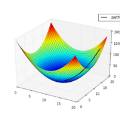Line segments are ubiquitous in our human-made world and are increasingly used in vision tasks. They are complementary to feature points thanks to their spatial extent and the structural information they provide. Traditional line detectors based on the image gradient are extremely fast and accurate, but lack robustness in noisy images and challenging conditions. Their learned counterparts are more repeatable and can handle challenging images, but at the cost of a lower accuracy and a bias towards wireframe lines. We propose to combine traditional and learned approaches to get the best of both worlds: an accurate and robust line detector that can be trained in the wild without ground truth lines. Our new line segment detector, DeepLSD, processes images with a deep network to generate a line attraction field, before converting it to a surrogate image gradient magnitude and angle, which is then fed to any existing handcrafted line detector. Additionally, we propose a new optimization tool to refine line segments based on the attraction field and vanishing points. This refinement improves the accuracy of current deep detectors by a large margin. We demonstrate the performance of our method on low-level line detection metrics, as well as on several downstream tasks using multiple challenging datasets. The source code and models are available at https://github.com/cvg/DeepLSD.
翻译:线段在我们的人工制造世界中无处不在,越来越多地用于视觉任务。由于空间范围和提供的结构信息,它们与特征点互补。传统的基于图像梯度的线检测器非常快和准确,但在嘈杂的图像和具有挑战性的条件下缺乏鲁棒性。它们的学习对应物更有可重复性并且可以处理具有挑战性的图像,但代价是较低的准确性和对线框线的偏见。我们提出结合传统和学习方法,以获得最佳效果:一种准确且鲁棒的线检测器,可以在野外训练而无需地面真实线条。我们新的线段检测器DeepLSD使用深度网络处理图像,以生成线吸引力场,然后将其转换为代理图像梯度幅度和角度,然后将其馈送给任何现有的手工制作的线检测器。此外,我们提出了一种基于吸引力场和消失点的新优化工具来优化线段。这种优化大大提高了当前深度检测器的准确性。我们在多个具有挑战性的数据集上展示了我们方法的性能,包括低级别的线检测指标以及多个下游任务。源代码和模型可在https://github.com/cvg/DeepLSD上获得。

